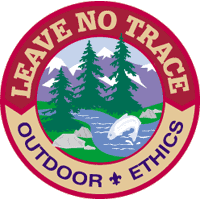
Minimize Campfire Impact
Bare Ground
Demonstrate how unnecessary campfires can consume scarce resources.
Goal
Participants will understand that limited resources should be left for natural habitat or emergency needs.
Time
15 minutes
Objectives
Participants will be able to:
- identify situations where campfires should not be used
- recognize the need for emergency fires
Materials
- a bag full (about 20) of clean, 1 foot long sticks (or dowels or popsicle sticks)
- a bag of scenarios cut into individual slips of paper:
- It's a beautiful, clear, cool night - perfect for stories around a crackling fire.
- On the 4th night of your week-long trek, you realize your backpack stove is out of fuel.
- You're just coming out of 5 nights in a wilderness area where campfires have been banned and this is the first night you can have a fire.
- One of the members of your group was returning to camp from a day hike. While crossing a deep creek by camp, he fell in. He is shivering and the temperature is 55 degrees and dropping.
- On an August camping trip, 3 of the 5 people in your group didn't bring raincoats and it has rained all day on the trail. They are now cold and wet, and have no dry, warm clothes left.
- One person in your group loves to fish and he caught his limit. You have no frying pans but someone knows how to roast fish on a stick over a fire.
- Your backpacking stove was dropped on a rock and is broken.
Motivator
- A forest area picked clean of wood, sticks, and twigs leaves bare ground, prone to erosion.
- Once the down wood is gone, people may start consuming standing and then live wood.
Presentation
- Spread the sticks around the floor and explain that each stick represents 1/2 hour worth of fuel to burn.
- Divide into groups of 3 or 4
- Have a team pick a scenario from the bag and read it out loud.
- If they decide to build a fire, they need to decide how long the fire will burn and gather that many sticks.
- Continue selecting scenarios until all the wood is consumed, discussing the value of having a fire for each scenario.
Reflection
- When you locate a place to camp, what should you take into account when deciding to build a fire or not? (scarcity of wood, actual need for fire, existing restrictions, weather conditions)


